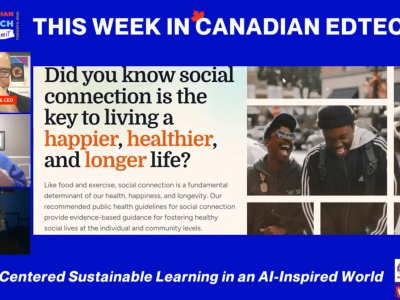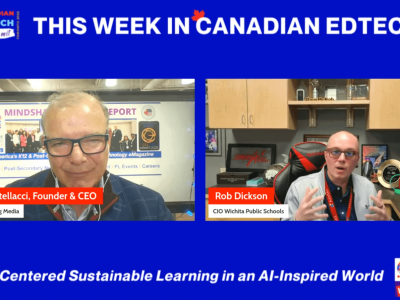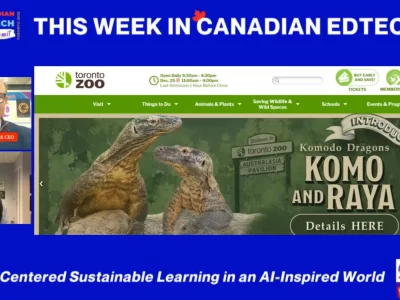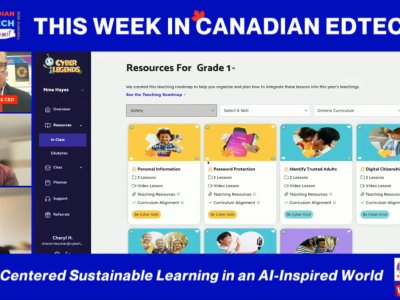By Timothy Gard, Educator, Toronto District School Board @MindShareK12
It’s out. Michael Fullan’s new book that is. If you haven’t yet had a chance to read Stratosphere then you should. In fact, you should put it at the top of your summer ‘must read’ list, even above that romantic novel you’ve been putting off until summer, or the latest installment of that mystery novel from your favourite mystery writer you’ve been intending to read. The reason for this is simple. You’ll need the summer to digest what Fullan has to say about technology, pedagogy and change knowledge. And further, you’ll need to read this book so that you can plan to implement what he has to say into your own classroom, school, district, province or state. The question is however, how do you do that? How can you take the ‘theory’ from Fullan’s ideas and work it into your practice? Below I’ve written about three ideas that you can use to ‘shape’ your way of thinking about your current practice so that you can change your old paradigm into a new more powerful one…if you haven’t already!
Create a Digital Filter for All Teaching Content
I don’t know about your particular context but in my context we continue to get the top-down approach: all materials, theory and classroom practice is enveloped in the old paradigm. Little time and effort is spent tweaking the content and the delivery modes so that it’s technology-rich. As a teacher you should take this ‘top-down’ content and ask deep questions of about how you would use the material in your classroom utilizing the latest tools in technology. If a solid, pedagogically-rich answer is not forthcoming then take the ‘bull by the horns’ and ‘re-create’ this content so that it adopts the new paradigm and share it with your colleagues.
Gone are the days where teachers should wait for the ‘demagogues’ to enhance teaching practice. With access to information at your fingertips, and social networking embedded at just about every level then why not bring the two together and filter the new ‘pathways’ through your need to use new tools. Are you getting new directives about how to enhance your literacy or mathematics program but without specific ways to include technology in the roll-out? Make every effort to take this new ‘pathway’ and show in real-ways how you would empower your teaching context using the new tools for a new age. And make sure you give this feedback to your school, and more specifically to the idea-makers who delivered the old paradigmatic approach. If we’re going to change the way we teach then we need to ensure that every stakeholder is aware of what technology can do to enhance and empower teaching and learning. To start this process we need to use a ‘thinking filter’ for the material that continues to flow down without the technology enhancers that our system so desperately needs to embrace.
Pursue the Four Criteria for Integrating Technology with Pedagogy
According to Fullan, the four criteria that one needs to consider for integrating technology with pedagogy so that there’s some seamless synergy are as follows: (i) Irresistibly Engaging; (ii) Elegantly Efficient; (iii) Always Available 24/7 (the first two criteria will not work without this ‘bridge’ piece); and (iv) Real-World Problem Solving.
These four criteria are very general to be sure but I think that if we use them to take a closer look at the technology that is currently being used to support pedagogy then we might find that we could refine, or even re-purpose much of what we currently use from the educational technology industry. These four criteria speak to the what really happens in real-world classrooms. Both students and teachers are addressed; teaching and learning is impacted because the ‘powers’ of technology are harnessed so that learning objectives are more easily met. Let me explain.
If you are going to integrate technology effectively then you must ensure that this technology is always available and always working the way it should. If you ask deep questions using the above mentioned criteria about whether the technology you currently use in your classroom is being utilized effectively with outcomes that clearly empower teaching and learning then you might need to reconsider how you might better employ your ‘new paradigm’. This should be a constant: reflective practice should now include teaching and learning with technology. If you haven’t started to use technology then I would suggest embedding the above criteria into your mindset before adopting any particular type of technology into your classroom or school context. Ask questions and expect solid answers from your tech purveyors, and make every effort to see technology as your ‘slave’ – it should serve your needs in engaging, and efficient ways all the time while helping you teach using real-world problem solving contexts.
Let me take interactive whiteboards for example. One of my frustrations with interactive whiteboard technology is that it does not work seamlessly in my teaching and learning environment; too much disruption happens in order to create a teaching and learning synergy. I need an always on, seamless and efficient way to utilize and embrace the ideas and concepts that are ever-flowing in my classroom context using the interactive technology without disengaging the students in the process. Teaching and learning in a dynamic, constructivist way includes a synergy and dynamic that is often hard to capture or enhance using an interactive whiteboard. How do we change this so that it becomes more engaging (engaging from moment to moment, and not lesson to lesson), and more efficient without destroying the harmony that we want to embrace in our classroom contexts? Perhaps this is why we should consider embracing all-in-one devices that capture everything an interactive whiteboard can do but at a personal level that can then be shared at a group level, or beyond.
If you use the above criteria to evaluate interactive whiteboard technology how well would this technology rate? I encourage you to use Fullan’s criteria to think about the effectiveness of interactive whiteboards in the classroom. That would be an interesting discussion.
Become an Activator and Change Agent
Take the risk this next year and change your classroom into a team. You become the Activator and Change Agent and students become co-participants on the road to discovering bigger ideas through a cogent use of Higher Order Thinking Skills. Take the time now to plan out how that might happen what it might look like and who could help you facilitate such a dramatic shift in your classroom context. Create a classroom where all curriculum material is delivered in such a way where students see it as participatory; where you act as the great ‘game master’ where problems are introduced, real-world problems become the norm and the expectations that you are expected to cover are covered seamlessly because your students are engaged in changing their world.
You won’t become an Activator or Change Agent however if you do not make every effort to move against the nay-sayers. You must battle inertia, skepticism, and indifference. These three obstacles are not easy to overcome, especially when you’re confronted with the skeptics, the vision-less, those people mired in the old paradigm. What would our world be like if we didn’t strive to move forward to improve our learning contexts?
I challenge you to take the little bit above and use it to help you re-think how you do things using technology in your classroom, school or district. Choose to make a difference so that your classroom, school or district adopts the new paradigm for teaching and learning. Make every effort to implement a solid plan for engaging the future with technology as a partner. And make every effort to introduce Fullan’s Stratosphere into your arsenal as a partner in this grand new adventure!










